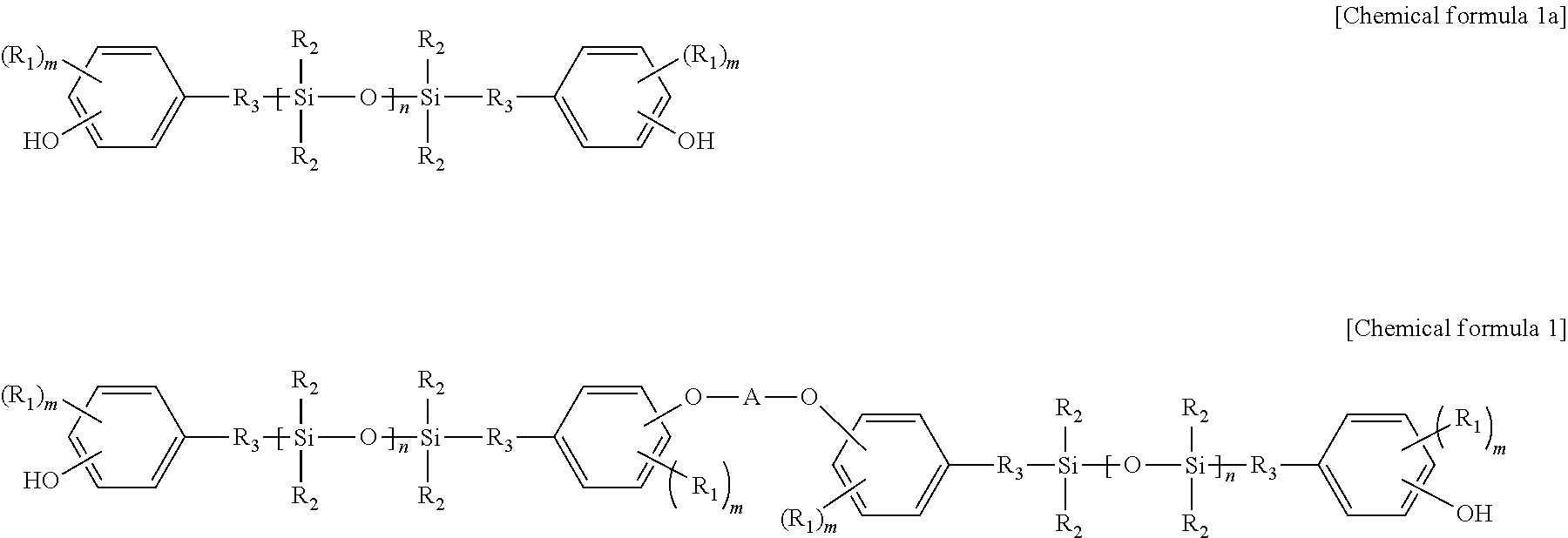Polysiloxane-polycarbonate copolymer and method of manufacturing the same
a polycarbonate and polymer technology, applied in the field of polysiloxanepolycarbonate copolymer and a manufacturing method, can solve the problems of deterioration of flowability and moldability, rapid degradation of impact resistance at low temperature, and increase of manufacturing costs, so as to improve the flowability of extrusion/injection molding, the effect of reducing the viscosity average molecular weight of the copolymer
- Summary
- Abstract
- Description
- Claims
- Application Information
AI Technical Summary
Benefits of technology
Problems solved by technology
Method used
Image
Examples
example 2
Preparation of Hydroxy-Terminated Siloxane
[0076]In a 100 mL three-necked flask equipped with a condenser, 0.03 mol of eugenol and 0.015 mol of polydimethylsiloxane were completely dissolved in 50 mL of chlorobenzene under nitrogen atmosphere, and then 0.00364 mmol of platinum catalyst (platinum(0)-1,3-divinyl-1,1,3,3-tetramethyldisiloxane complex) was added thereto. The resulting solution was then refluxed for 24 hours, and the solvent was removed therefrom. The product was washed with distilled water to obtain hydroxy-terminated siloxane of the following chemical formula 7 (Mn:8,044).
[0077]
[0078]
[0079]An interfacial reaction of bisphenol A in an aqueous solution and phosgene gas was conducted in the presence of methylene chloride to prepare 400 mL of an oligomeric polycarbonate mixture having a viscosity average molecular weight of about 1,000. To the obtained oligomeric polycarbonate mixture, 4.5% by weight of the hydroxy-terminated siloxane having ester linkage of chemical formul...
example 3
[0080]The polysiloxane-polycarbonate copolymer was prepared by the same method as described in Example 2, except that the hydroxy-terminated siloxane (Mn: 12,141) having ester linkage of the following chemical formula 8 was prepared and used in an amount of 4.5% by weight. The physical properties of the prepared polysiloxane-polycarbonate copolymer were measured, and the results are shown in Table 1 below.
[0081]
example 4
[0082]The polysiloxane-polycarbonate copolymer was prepared by the same method as described in Example 2, except that the hydroxy-terminated siloxane (Mn:7,000) having ester linkage of the following chemical formula 9 was prepared and was used in an amount of 4.5% by weight, and 2.6 g of p-tert-butylphenol (PTBP) was used. The physical properties of the prepared polysiloxane-polycarbonate copolymer were measured, and the results are shown in Table 1 below.
[0083]
PUM
| Property | Measurement | Unit |
|---|---|---|
| molar ratio | aaaaa | aaaaa |
| molar ratio | aaaaa | aaaaa |
| temperature | aaaaa | aaaaa |
Abstract
Description
Claims
Application Information
 Login to View More
Login to View More - R&D
- Intellectual Property
- Life Sciences
- Materials
- Tech Scout
- Unparalleled Data Quality
- Higher Quality Content
- 60% Fewer Hallucinations
Browse by: Latest US Patents, China's latest patents, Technical Efficacy Thesaurus, Application Domain, Technology Topic, Popular Technical Reports.
© 2025 PatSnap. All rights reserved.Legal|Privacy policy|Modern Slavery Act Transparency Statement|Sitemap|About US| Contact US: help@patsnap.com



